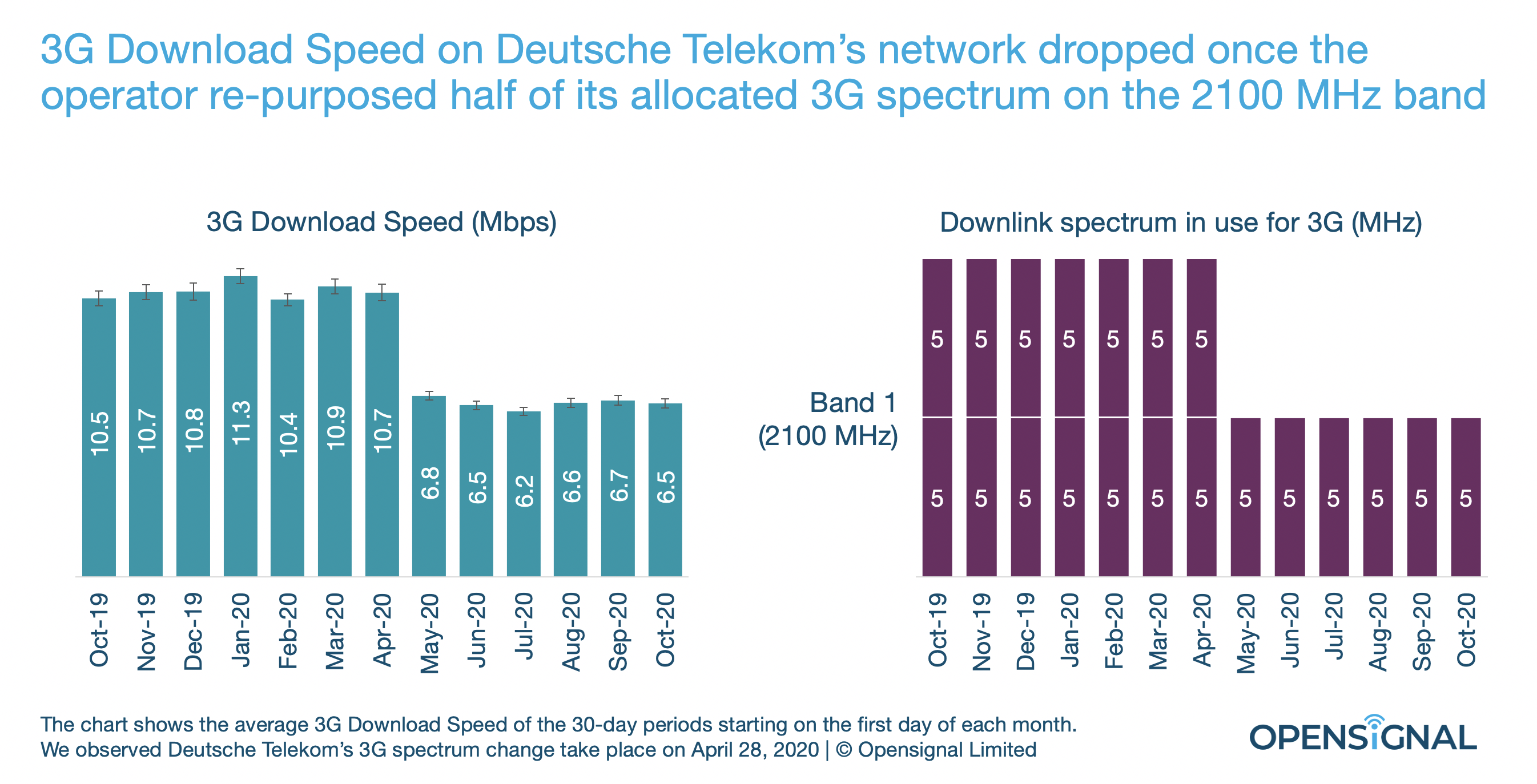More than 18 months have passed since the U.S. and South Korea saw the first mobile 5G commercial launches in April 2019. However, 5G spectrum is still a scarce resource for many operators, who are looking to acquire more spectrum in upcoming auctions and repurpose some or all of the spectrum that they are currently using for 3G and/or 4G networks.
In Germany, all operators have outlined 3G sunset dates, when they will switch off their 3G networks and swap that capacity to support the bulk of their users on newer technologies like 4G and 5G. But Opensignal has already seen changes in Deutsche Telekom’s 3G network: at the end of April 2020, we observed Deutsche Telekom re-purpose part of its existing 3G spectrum towards 4G and 5G networks, with a particularly evident impact on users’ experience.
However, even today there are still users relying on those 3G networks. In November 2019, our analysis showed that many German smartphone users had never accessed mobile data on a 4G network because they did not have a 4G tariff plan. Operators must then be careful when they re-purpose 3G spectrum to not restrict their users’ access to 4G based on a tariff choice, in order to minimize any adverse impact on their users’ mobile network experience.
Overall Download Speed Experience improved as Telekom re-deployed 3G spectrum for 4G and 5G
Telekom has boosted its 5G network adding spectrum on its 2100 MHz band to the 3.6GHz band used for Telekom’s initial 5G launch. It has also deployed Dynamic Spectrum Sharing (DSS), which enables Telekom to operate both 4G and 5G mobile communications standards in parallel in one frequency band.

Our data shows that Telekom has refarmed a 5 MHz paired block on the 2100 MHz band which was previously used for 3G for newer technologies. Also, Telekom has deployed an additional 10 MHz of paired spectrum on the 2100 MHz band to support its 4G and 5G users which was previously unused. We have observed Telekom using this 15 MHz of paired spectrum on the 2100 MHz band particularly in less densely populated areas which suggests that Telekom is aiming to boost its rural users’ mobile experience using newer technologies like 4G and over time also provide a 5G connection through the use of DSS.
This allocation of additional capacity contributed to the 24.4% increase of Telekom’s Download Speed Experience that we observed between the months of May and October 2020. This means that, even though users saw 3G Download Speed decrease, the overall impact on Telekom users’ mobile experience was positive.
3G download speeds dropped as Telekom repurposed half of its 2100 MHz spectrum used for 3G
We observed that Telekom was using two 5 MHz downlink channels on band 1 — the 2100 MHz band — to support its 3G users up to the end of April. However, after that date Telekom started to use just a single 5 MHz channel for 3G. This change had a significant impact on our 3G users’ mobile network experience on Telekom’s network as 3G download speeds dropped from around 10.8 Mbps, which we observed in the seven months prior to the spectrum change, to 6.6 Mbps afterwards.

Similarly, we observed significant reductions in other measures of our Telekom users’ 3G mobile experience. We saw that reducing the amount of spectrum allocated to 3G users affected their whole mobile experience and did not only impact their download speeds. For example, Telekom’s 3G Video Experience score decreased from 71.5 on a 0-to-100 points scale to 63.8 between our two latest reports, which looked at different time periods: one before that spectrum change, and the other after. Compared with the other two mobile operators in Germany, Vodafone’s 3G Video Experience score was practically unchanged across the two reports, moving ever so slightly from 60.7 to 60.8 points, while O2’s score decreased from 64 to 60.5 points.
Despite large swaths of new spectrum being allocated in the recent 5G auctions, spectrum remains a limited key resource for mobile operators in many countries including Germany. By repurposing 3G spectrum, mobile operators can quickly deploy additional capacity to support the increasing demand on 4G and 5G networks. This means that the bulk of users who connect to 4G and 5G networks will see their experience improve, but existing 3G users on those networks might see a negative impact to their mobile experience.
Opensignal Limited retains ownership of this insight including all intellectual property rights, data, content, graphs & analysis. Reports and insights produced by Opensignal Limited may not be quoted, reproduced, distributed, published for any commercial purpose (including use in advertisements or other promotional content) without prior written consent. Journalists are encouraged to quote information included in Opensignal reports and insights provided they include clear source attribution. For more information, contact [email protected].
